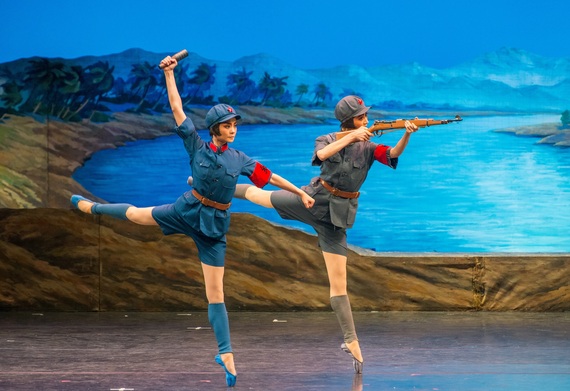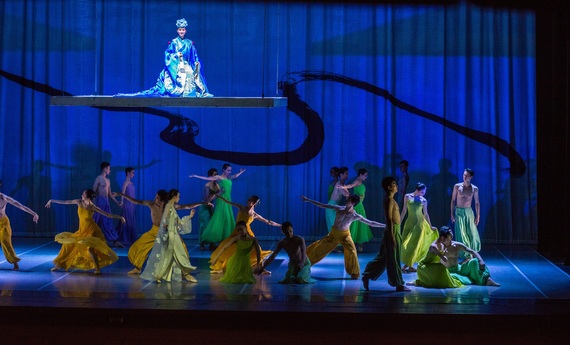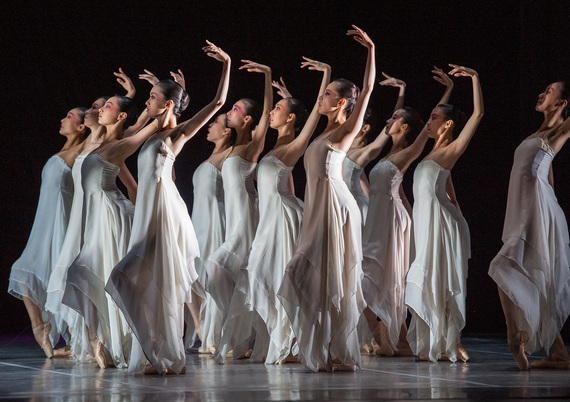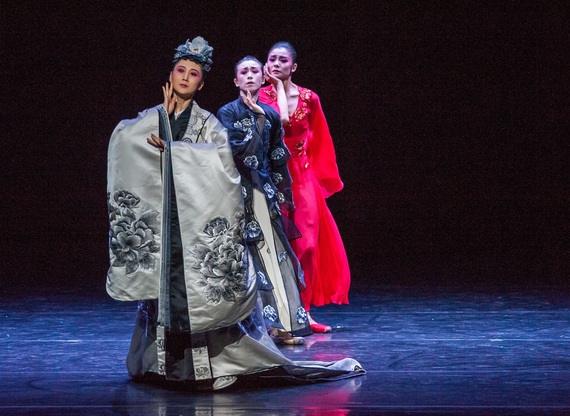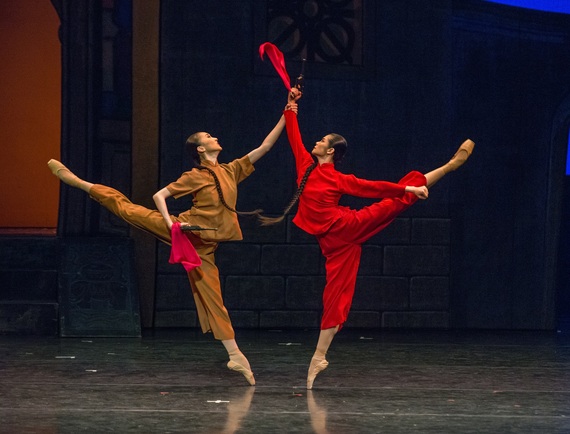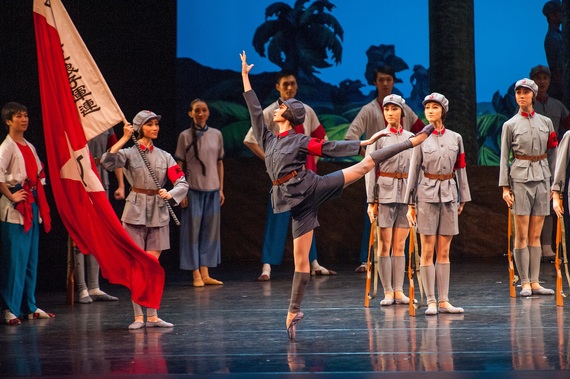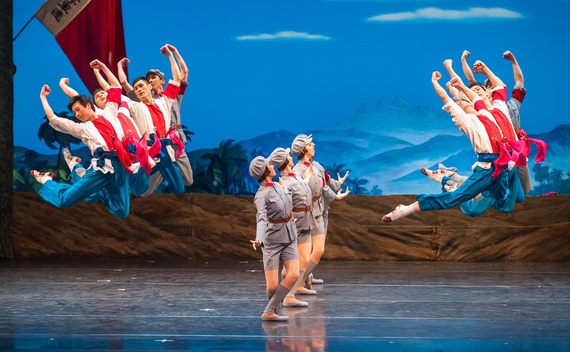The National Ballet of China performed last week at the David H. Koch Theater as the sole dance offering for Lincoln Center Festival. They presented two programs: first, The Peony Pavilion, created in 2008 based on a Chinese opera from the Ming dynasty, and closed their run with The Red Detachment of Women, a 1964 propaganda ballet promoting communist social ideas (including gender equality) fusing Western ballet with traditional Chinese dance and martial arts. The two works contrasted and complemented each other as duel statements on Chinese culture by Chinese artists of different eras, and offered a suggestion of the future artistic trajectory of the company.
Ballet in China is only a few generations old. The Beijing Dance School (now Beijing Dance Academy) was founded in 1954, twenty years after George Balanchine founded the School of American Ballet in New York. Within five years, the Experimental Ballet Company of the school was renamed the National Ballet of China. The efforts were headed up by Dai Ailian (the "Mother of Contemporary Chinese Dance") and Russian Pyotr Gusev (a Petersburg friend of Balanchine, he became the director of the Kirov Theatre before helping set up ballet in China. He is remembered for petitioning UNESCO to declare April 29 as International Dance Day, and credited with choreographing the Gamzatti variation performed today in Petipa's La Bayadere.). Under the Cultural Revolution, Jiang Qing (Madame Mao) assumed control of the ballet company and school, canonizing only two ballet works to be included in the "Eight Model Plays" allowed to be performed in China, the Red Detachment of Women and The White Haired Girl. Following Madame Mao's arrest upon Chairman Mao's death, artistic control was reinstated to Ailian, who continued to bring new dance ideas into China. In 2009, Feng Ying took over as Artistic Director of the Company. With the presentation at Lincoln Center, American audiences are given the chance to see the past, present, and future of China's voice in ballet.
Presented first, The Peony Pavilion from 2008 is a dream in every sense of the word: it employs a loose narrative rich with imagery. The plot includes themes from Orpheus and Eurydice, and is comparable to La Bayadere and The Pharaoh's Daughter in the Western Ballet canon: Girl meets Boy in a dream. Girl is consumed by love and dies. Girl goes to the Underworld and is told to return to life and fulfill her love destiny to marry Boy (it turns out he's real!) Girl comes back and marries Boy. The narrative in the ballet however is not as linear as Western audiences may be used to. For example, the heroine Du Liniang (exquisitely danced by Zhu Yan), realizes in her dream state that she is joined by two alter egos: a Peking Opera singer and a Flower Goddess, representing the internal struggle of nature and culture that defines her humanity. An abstract and colorful melodrama, one must be willing to let go and be swept up in the overall landscape of metaphors.
There are many moments in the ballet that fuse East and West. The music composed and orchestrated by Guo Wenjing is an eclectic mix of Debussy, Ravel, Resphighi, Holst and Prokofiev, dusted with a fine layer of Peking Opera. Zhang Yuanyuan as the singer is a beautiful component of the Du Liniang's trinity, often circles the dance action with many small steps creating an illusion of gliding. Traditionally, in Peking Opera, this signifies that a character is undertaking a long journey, in this context, showing the long journey to and from the afterlife. The Flower Fairies provide the narrative with a "Ballet en Blanc," a corps of women all in white performing in unison, their arms reaching upward like stamen. The port de bra ("carriage of the arms") breaks at the elbow and correspondingly at the wrist to create sharp angles with the arms, as with traditional water sleeve performances. Stylistically, this is a departure from the rounded carriage of the Danish and the efficiency of the Americans; the Chinese dancers' arms twist and ripple through the air like incense. The final scene ends with a very Chinese Happily Ever After, the complete wedding party in red running in a large circle. This production hints that the future of ballet in China will continue to draw inspiration from its millennia of stories and told through a culturally-hybrid dance form.
I wasn't sure about attending The Red Detachment of Women, a propaganda ballet from the Cultural Revolution that glamorizes the disastrous human conditions under that period. Having grown up in Hong Kong, I watch with great trepidation as democracy is slowly being dismantled from a society and micro-culture that has lived too many generations to function any other way. Politics aside, would infusing communist ideology with classical ballet degrade the artform? Or was it just a different story than the one I was used to hearing? Was this so different than putting ballet on the ranch, like in Agnes de Mille's classically American Rodeo? Either way, I was reminded that while "Swan Lake" was created for the aristocracy, "Red Detachment" was created for the people, and therefore would be fun, flashy, colorful, and obvious.
The ballet begins with the heroine, Qionghua, chained, enslaved, and sexualized. Her captors loosen her shackles, and she thrusts her arched foot forward in a defiant tendu. Breaking free, she flees into a storm, where once re-captured, she is beaten and left for dead. A spotlight suddenly turns on the Red Army cadre, he strikes a heroic pose as the triumphant brass blares. He is the Hero, and the audience bursts into applause, reminiscent of Aurora's first entrance in The Sleeping Beauty. Sending Qionghua to the Red Area, they look outwards and strike a hopeful and triumphant tableau, her leg raised in a low arabesque behind her. With the cymbals crashing, the audience erupted into cheers again. It's worth noting that this was not the usual audience that attends New York City Ballet and other programming at this venue and, not surprisingly, primarily Chinese. Clapping on rhythm to the music as the curtain rose for the next act, the audience cheered again at the depiction of the Red Area, a colorful land of plenty. A female military corps in bright gray uniforms weave patterns that mirror folk dances, brandishing swords with clenched fists. These are not Sylphs, but strong, disciplined Amazons, armed with handguns and sickles and performing in full classical synchronization. Qionghua bows in humility, clutching her braid ("but I am a woman..."). She is raised up by the female general, who greets her with her arms out and palms out, saying: No more kowtowing, this is how we greet each other here -- as equals. Qionghua embraces the flag, and joins the revolutionary movement.
The place of women in the ballet is worth mentioning. In many Western ballets like Swan Lake, Giselle, and The Sleeping Beauty, the female protagonists are the victims of their surroundings; their fate lies in the hands of the men. Choreographically, the woman is presented in front and supported by the man behind, expanding the technical possibilities of the steps she can take, and showing the beauty and a chivalry of an ideal Western heterosexual partnership. In China during the Cultural Revolution, partnered pirouettes and lifts were banned, limiting the choreographic possibilities. There is also an absence of a romantic storyline, the only passion on stage is dedicated to the State, which diminishes the importance of relying on a male protagonist. As Americans continue to grapple with gender wage equality, maternal leave, and abortion rights, it was refreshing to see a ideal picture of gender equality presented on stage - however historically inaccurate as a depiction of Communist China.
In the second act, we see the Red military advance and the appearance of food and plenty with each liberation from tyranny. The battle reaches a climax when a seemingly unending line of men leap cross the front of the stage in a series of grand jetes in perfect union. Our heroine Qionghau provides the gamechanger, killing the Tyrant. The Red Army marches forward to "The Internationale," the anthem of the Communist Party of China (some members of the audience join in with the singers). The ballerinas maintain their characters as members of the State during the curtain call; in the face of a roaring reception from the audience, they humbly salute as the curtain goes down. Yet their faces brim with pride, knowing that they have conquered New York.

